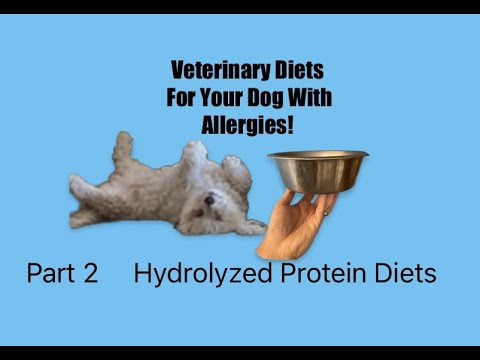
Hydrolyzed protein dog food represents a significant advancement in veterinary nutrition, designed to address food sensitivities and allergies in canines.
This specialized diet breaks down protein molecules into smaller components, making them less likely to trigger immune responses in sensitive dogs.
By understanding the benefits of this diet, pet owners can make informed decisions about their dog’s nutritional needs, especially for those with chronic health issues.
Key Takeaways
- Hydrolyzed protein dog food is designed to address food sensitivities and allergies in canines.
- The specialized formulation process breaks down protein molecules into smaller components.
- This diet is typically prescribed for dogs suffering from food allergies and digestive sensitivities.
- Understanding the benefits can help pet owners make informed decisions about their dog’s nutritional needs.
- Hydrolyzed protein dog food can improve the quality of life for dogs with specific medical conditions.
Understanding Hydrolyzed Protein Dog Food

The concept of hydrolyzed protein dog food revolves around breaking down proteins into smaller components. This process is crucial for dogs that have adverse reactions to certain proteins in their diet.
What Is Hydrolyzed Protein?
Hydrolyzed protein refers to protein that has been broken down into smaller peptides and amino acids through a process known as hydrolysis. This chemical process involves the use of enzymes to cleave the protein molecules, resulting in fragments that are less likely to trigger an immune response.
By breaking down proteins into smaller pieces, hydrolysis makes it possible to create dog food that is hypoallergenic. This is particularly beneficial for dogs that suffer from food allergies or sensitivities.
The Science Behind Hydrolysis Process
The hydrolysis process is a complex biochemical reaction that involves the use of specific enzymes to break down protein molecules. During this process, water molecules are introduced to facilitate the breaking of peptide bonds, resulting in smaller protein fragments and free amino acids.
| Key Aspect | Description | Benefit |
|---|---|---|
| Enzyme Usage | Specific enzymes are used as catalysts to break chemical bonds between amino acids. | Efficient breakdown of proteins |
| Degree of Hydrolysis | The extent of hydrolysis can be controlled to achieve optimal protein fragment size. | Balances hypoallergenicity and nutritional value |
| Molecular Weight | Proteins are hydrolyzed to a molecular weight below 10,000-12,000 daltons. | Reduced immune response |
The science behind hydrolysis has evolved, enabling the production of palatable hydrolyzed protein dog food formulas that dogs find appealing.
How Hydrolyzed Protein Dog Food Works in the Canine Body

The effectiveness of hydrolyzed protein dog food lies in its ability to alter the protein structure, making it unrecognizable to the dog’s immune system. This unique characteristic allows dogs to benefit from the nutritional value of proteins without triggering allergic reactions. By understanding how hydrolyzed protein dog food works, pet owners can make informed decisions about their dog’s diet.
Breaking Down Proteins Into Amino Acids
Proteins are complex molecules that can be broken down into simpler amino acids through hydrolysis. This process involves using water to chemically split the proteins into smaller pieces. As a result, the proteins lose their original structure and become less likely to trigger an immune response.
| Process | Description | Outcome |
|---|---|---|
| Hydrolysis | Breaking down proteins using water | Smaller protein pieces |
| Protein Structure Alteration | Changing the molecular structure of proteins | Reduced immune response |
| Amino Acid Production | Creating simpler amino acids | Nutritional benefits without allergies |
Bypassing the Immune Response
When proteins are hydrolyzed, their molecular structure is altered significantly. The dog’s immune system, which typically identifies proteins by their specific structures, no longer recognizes these hydrolyzed proteins as potential threats. This ‘molecular disguise’ enables dogs to receive the nutritional benefits of proteins without experiencing allergic reactions.
The dog immune system typically identifies proteins by their specific molecular structures, which serve as antigens that can trigger allergic reactions in sensitive dogs. When proteins are hydrolyzed, their molecular structure is altered to the point where the immune system no longer recognizes them as potential threats.
For dogs with food sensitivities, this bypassing of the immune response can prevent symptoms like itching, digestive upset, and chronic inflammation. Scientific studies have demonstrated a significant reduction in allergic symptoms when dogs with known food allergies are switched to appropriately hydrolyzed protein diets.
Common Health Conditions Treated with Hydrolyzed Protein Dog Food
Hydrolyzed protein dog food is a dietary approach used to manage various health issues in dogs, particularly those related to the gastrointestinal tract and immune system. The use of hydrolyzed protein dog food is a common approach to addressing various health issues in canines.
Food Allergies and Sensitivities
Dogs suffering from food allergies or sensitivities can benefit from hydrolyzed protein dog food. These conditions occur when a dog’s immune system reacts to a particular ingredient in their diet, often resulting in skin issues or gastrointestinal symptoms. By breaking down proteins into smaller components, hydrolyzed protein diets minimize the likelihood of an adverse reaction, providing relief to dogs with these sensitivities.
Key benefits of hydrolyzed protein dog food for dogs with food allergies include reduced allergic reactions and improved digestive health. This is because the proteins are pre-digested, making them less likely to trigger an immune response.
Inflammatory Bowel Disease (IBD)
Inflammatory bowel disease (IBD) is a condition characterized by chronic inflammation of the gastrointestinal tract, leading to symptoms such as diarrhea, vomiting, weight loss, and lethargy. Hydrolyzed protein dog food is often used to manage IBD by reducing the antigenic load on the digestive system. The pre-digested nature of hydrolyzed proteins makes them easier to absorb, potentially improving the nutritional status of dogs with IBD.
The effectiveness of hydrolyzed protein dog food in managing IBD is supported by clinical studies, which have shown significant improvement in dogs placed on such diets. A summary of the benefits and characteristics of hydrolyzed protein dog food for IBD management is provided in the following table:
| Condition | Symptoms | Benefits of Hydrolyzed Protein Dog Food |
|---|---|---|
| Food Allergies | Skin issues, gastrointestinal symptoms | Reduced allergic reactions, improved digestion |
| Inflammatory Bowel Disease (IBD) | Diarrhea, vomiting, weight loss, lethargy | Easier absorption, reduced inflammation |
In conclusion, hydrolyzed protein dog food is a valuable dietary tool for managing health conditions such as food allergies and IBD in dogs. By understanding the benefits and characteristics of this type of dog food, pet owners can make informed decisions about their dog’s diet.
Recognizing Signs Your Dog May Need Hydrolyzed Protein Diet
It’s crucial for dog owners to recognize the signs that indicate their pet may benefit from a hydrolyzed protein diet. Dogs with food allergies or sensitivities often exhibit specific symptoms that can be alleviated with the right dietary adjustments.
Allergy Symptoms in Dogs
Dogs suffering from food allergies may display a range of symptoms, including gastrointestinal issues and lethargy. Gastrointestinal (GI) issues can manifest as nausea, stomach upset, diarrhea, and excessive gas. If your dog appears bloated and fatigued, it could be indicative of a food allergy.
Some common signs of food allergies in dogs include:
| Symptom | Description |
|---|---|
| Chronic Diarrhea | Diarrhea that persists despite deworming and basic dietary changes. |
| Vomiting | Vomiting, especially when it occurs several hours after eating or on a recurring basis. |
| Excessive Flatulence | Excessive gas and abdominal discomfort, often indicated by a hunched posture. |
Digestive Distress Indicators
Digestive distress in dogs can be identified through various indicators, including inconsistent stool quality, unexplained weight loss, and changes in appetite. Noisy digestive sounds (borborygmi) and frequent stomach gurgling may also signal irregular gut motility related to food-induced inflammation.
The following table summarizes key digestive distress indicators:
| Indicator | Possible Cause |
|---|---|
| Inconsistent Stool Quality | Alternating between normal, loose, and sometimes constipated stools. |
| Unexplained Weight Loss | Weight loss despite normal or increased food consumption. |
| Visible Mucus or Blood in Stools | Intestinal inflammation that may respond well to hydrolyzed protein diets. |
Key Benefits of Hydrolyzed Protein Dog Food
Hydrolyzed protein dog food is a game-changer for pet owners dealing with their dogs’ food allergies and sensitivities, offering a scientifically-backed dietary solution. This type of dog food provides several key benefits, improving the overall health and well-being of dogs with specific dietary needs.
Reduced Allergic Reactions
One of the primary advantages of hydrolyzed protein dog food is its ability to reduce allergic reactions in dogs. By breaking down proteins into smaller components, this food type minimizes the likelihood of an immune response, thereby alleviating symptoms associated with food allergies.
Improved Digestive Health
Hydrolyzed protein dog food also contributes to improved digestive health. The hydrolysis process makes the proteins more easily digestible, reducing the strain on a dog’s digestive system and potentially alleviating symptoms of digestive distress.
Diagnostic Tool for Food Allergies
Moreover, hydrolyzed protein dog food serves as a valuable diagnostic tool in identifying food allergies. Veterinarians often recommend an elimination diet using hydrolyzed protein dog food to diagnose allergies accurately. As noted by veterinary dermatologists, “Hydrolyzed protein elimination diets are considered the gold standard for diagnosing food allergies in dogs with complex or atypical presentation.”
“The diagnostic process using hydrolyzed protein diets has been refined through decades of clinical research, providing reliable results when protocols are strictly followed.”
The benefits of hydrolyzed protein dog food are multifaceted, ranging from reducing allergic reactions and improving digestive health to serving as a critical tool in diagnosing food allergies. For pet owners navigating the challenges of canine food allergies, this dietary option offers a beacon of hope for improving their pets’ quality of life.
Potential Drawbacks and Considerations
The use of hydrolyzed protein dog food is not without its considerations. While it serves as a valuable temporary solution for dogs suffering from allergies, its long-term use requires careful evaluation.
Possible Side Effects
Some dogs may experience side effects or have specific needs that aren’t fully addressed by hydrolyzed protein dog food. For instance, weight management can become a concern as some dogs might lose weight due to reduced palatability, while others might gain weight because of the increased digestibility of the hydrolyzed formulas.
Moreover, dogs with concurrent diseases such as kidney disease, liver disease, or diabetes may require specially formulated hydrolyzed diets that cater to both their food sensitivities and other medical conditions.
Nutritional Considerations
Nutritional adequacy is a critical factor when considering hydrolyzed protein dog food. The nutritional profiles of these foods can vary significantly, making it essential to select a product that meets all your dog’s nutritional needs, especially if it’s to be used long-term.
| Nutritional Aspect | Consideration | Recommendation |
|---|---|---|
| Protein Source | Ensure it’s hydrolyzed and not soy or other ingredients | Choose animal-based protein sources |
| Mineral and Vitamin Levels | May be altered compared to conventional diets | Consider supplementation if necessary |
| Omega Fatty Acids Balance | May differ from conventional foods | Ensure proper supplementation for skin and coat health |
It’s also important to work closely with veterinarians to monitor nutritional adequacy through regular physical examinations, weight checks, and occasionally, bloodwork for dogs on long-term hydrolyzed diets.
Ultimately, while hydrolyzed protein dog food can be a lifesaver for dogs with severe allergies, its use should be accompanied by careful consideration of the potential drawbacks and nutritional implications.
Making the Transition to a Healthier Diet for Your Dog
Making the switch to hydrolyzed protein dog food requires patience and a well-planned approach. To minimize digestive upset, it’s essential to transition your dog gradually over 7-10 days.
Begin by mixing a small amount (25%) of the hydrolyzed protein food with their current diet, gradually increasing the proportion until the transition is complete. During this period, avoid all treats, table scraps, and flavored medications unless approved by your veterinarian.
Maintaining detailed records of your dog’s symptoms and tracking improvement is crucial. Most dogs require at least 8-12 weeks on the hydrolyzed protein diet before maximum improvement is seen.



